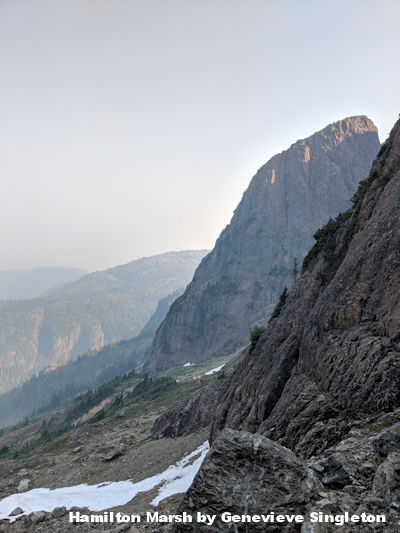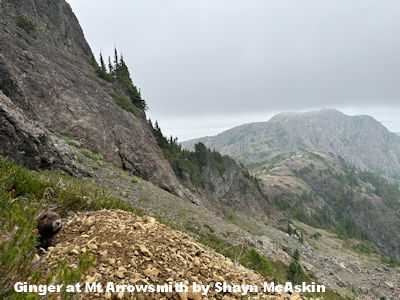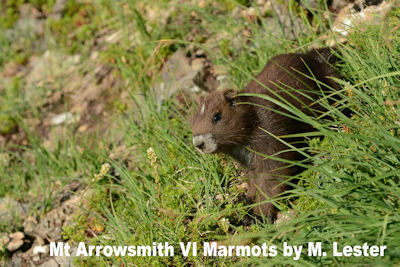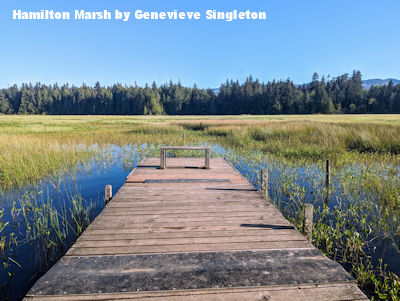| North in the Spring #29: Mt Arrowsmith Biosphere
by John Neville  In May 2024 we attended the BC Nature AGM, in the Civic Center at Qualicum Beach. It was a very friendly event, comprising a gathering of caring people. I was immediately struck by repeated mention of the passing of Al Grass, his knowledge and willingness to share! Many greetings, hugs and reminisces were exchanged, including one member whom I had not seen for 30 years and our joint pleasure recalling recording of Meadowlarks in the Okanagan. The Mount Arrowsmith biosphere Region was designated by UNESCO and the Province in 2000 in response to conservationalists like the Arrowsmith Naturalists-to prevent more logging. This Biosphere Region is located on the east shore of Vancouver Island, reaching westwards up the Little Qualicum, Frenchman and Englishman watersheds to the top of Mount Arrowsmith. The ambitious target was to protect biodiversity in a large second growth Coastal Douglas Fir ecosystem. In 2014 the University of Vancouver Island, established the Mount Arrowsmith Biosphere Region Research Institute. This body is governed by the Qualicum Nation, the Smaw--naw--as Nation, City of Parksville, town of Qualicum Beach, Regional District of Nanaimo, BC Ministry of Environment, Vancouver Island Land Management, Island Timberland, Timberwest, and Vancouver Island University.
In May 2024 we attended the BC Nature AGM, in the Civic Center at Qualicum Beach. It was a very friendly event, comprising a gathering of caring people. I was immediately struck by repeated mention of the passing of Al Grass, his knowledge and willingness to share! Many greetings, hugs and reminisces were exchanged, including one member whom I had not seen for 30 years and our joint pleasure recalling recording of Meadowlarks in the Okanagan. The Mount Arrowsmith biosphere Region was designated by UNESCO and the Province in 2000 in response to conservationalists like the Arrowsmith Naturalists-to prevent more logging. This Biosphere Region is located on the east shore of Vancouver Island, reaching westwards up the Little Qualicum, Frenchman and Englishman watersheds to the top of Mount Arrowsmith. The ambitious target was to protect biodiversity in a large second growth Coastal Douglas Fir ecosystem. In 2014 the University of Vancouver Island, established the Mount Arrowsmith Biosphere Region Research Institute. This body is governed by the Qualicum Nation, the Smaw--naw--as Nation, City of Parksville, town of Qualicum Beach, Regional District of Nanaimo, BC Ministry of Environment, Vancouver Island Land Management, Island Timberland, Timberwest, and Vancouver Island University.
It's area is 118.300 h or 1.183 km2. Some of the protected areas within the Biosphere are: Arbutus Grove Provincial Park, Englishman River Regional Park, Englishman River Falls Provincial Park, Little Qualicum Provincial Park, Macmillan Provincial Park, Mount Arrowsmith Massif Regional Park, Spider Lake Provincial Park and Qualicum National Wildlife Area. We had time to visit Rathtrevor Beach Provincial Park which is a treasure. In the past we have observed the Brant Geese from that park during the Brant Festival. On this occasion we followed a trail through the woods, over a marsh, and past a fenced field being allowed to grow naturally. A four year old boy ran up to us, clutching something to his chest: then he proudly revealed part of a Robin's eggshell! His grand-parents, like us, were reminded why we need to protect nature! 
The story of Biosphere Reserves began in 1968, with UNESCO for the purpose of Education and protection. How to showcase places where man and nature are living in harmony. So far, UNESCO has designated 748 sites, which includes 19 in Canada. The Biosphere philosophy and the challenges were topics of the conference. For example, a rich diverse meadow area, Herewood Flats, has currently been sold to a developer. Many conservationalists are actively fundraising to purchase and prevent it's destruction. The human population is growing, more houses are needed, but how to retain the rich biodiversity! The key note speaker at the conference, Dr. Loys Mangnon said and illustrated that: “biodiversity is a very complex issue”. We all know that reintroducing wolves to Yellowstone Park reduced the Elk herds and has improved tree and shrub growth for Beaver. The shade over waterways has restored fish populations. In contrast, stopping the Cod fishery was not only too late, but other changes have occurred and the fish are not recovering. In Haida Gwaii, Sea Otters are starting to repopulate the coast. In their absence, the people have been successfully harvesting Urchin and Abalone. As the Otter population increases, Urchins and Abalone will decrease, but Kelp forests will be restored! The loss of income from Abalone and Urchin will have to be balanced against the return of Otters and Kelp.  On Mt Arrowsmith a really encouraging story is unfolding: Vancouver Island Marmots were re-introduced in 2008 and 09. This years count shows that all 27 wild animals have survived from last year and there is at least one new litter living on the mountain and saddle area towards Mt Cokely. On Mt Arrowsmith a really encouraging story is unfolding: Vancouver Island Marmots were re-introduced in 2008 and 09. This years count shows that all 27 wild animals have survived from last year and there is at least one new litter living on the mountain and saddle area towards Mt Cokely.
This is the second largest colony after Mount Washington in the recovery program. Adam Taylor thinks that hikers on the steep park trails may have deterred predation by cougars and wolves? The 360 h. of Hamilton Marsh typify what this biosphere is all about. Seven springs provide water year round: much of it believed to flow from the snow pack on Mount Arrowsmith. Liz Bredberg and Genevieve Singleton were the trip leaders for the lucky members of the conference who took part in this trip. A trail from South Hillier Rd takes you .8 km through the marsh, ending on a floating dock. A conveniently placed bench is very popular with visitors for wildlife viewing. have been counted. The Flora and Fauna numbers are amazing: more than 30 species of Dragonfly, 14 species of trees, 18 species of shrubs and a check-list of 120 birds have been counted. Sitting on the bench you might see Beaver, Muskrat, Three-spined Stickleback, Cutthroat Trout, Coho Salmon, amphibians including the introduced Bull frog. The Ephemoral Ponds in the forest provide breeding areas for Salamanders in spring. For a more complete list of plants, including moss's, fungi and lichen, go to: https://hamilton-marsh.com or the report by Elizabeth Bredberg PHD called the Hamilton Wetlands and Forest.  The Conference this year was a memorable experience, and we are grateful to the Arrowsmith Naturalists and other naturalists from the area for being wonderful hosts. We also learnt at the AGM what a great job the Executive and staff of BC Nature are doing on our behalf. Thank you all!
The Conference this year was a memorable experience, and we are grateful to the Arrowsmith Naturalists and other naturalists from the area for being wonderful hosts. We also learnt at the AGM what a great job the Executive and staff of BC Nature are doing on our behalf. Thank you all!
|